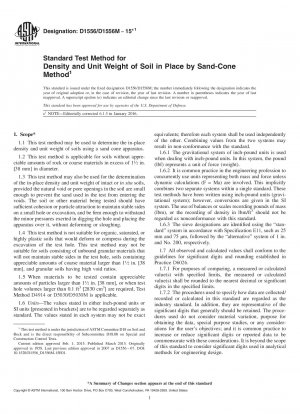ASTM D1556/D1556M-15e1
Standard Test Method for Density and Unit Weight of Soil in Place by Sand-Cone Method
- Standard No.
- ASTM D1556/D1556M-15e1
- Release Date
- 2015
- Published By
- American Society for Testing and Materials (ASTM)
- Latest
- ASTM D1556/D1556M-15e1
- Scope
5.1 This test method is used to determine the density and water content of compacted soils placed during the construction of earth embankments, road fill, and structural backfill. It often is used as a basis of acceptance for soils compacted to a specified density or percentage of a maximum density determined by a test method, such as Test Methods D698 or D1557.
5.1.1 Test Methods D698 and D1557 require that mass measurements of laboratory compacted test specimens be determined to the nearest 1 g, so that computed water contents and densities can be reported to three and four significant digits, respectively. This standard is a field procedure requiring mass measurements to the nearest 0.01 lbm [5 g]. As such, water content calculations should only be reported to nearest 18201;% and density to three significant digits.
5.2 This test method can be used to determine the in-place density of natural soil deposits, aggregates, soil mixtures, or other similar material.
5.3 The use of this test method is generally limited to soil in an unsaturated condition. This test method is not recommended for soils that are soft or friable (crumble easily) or in moisture conditions such that water seeps into the hand excavated hole. The precision of the test may be affected for soils that deform easily or that may undergo a volume change in the excavated hole from vibration, or from standing or walking near the hole during the test (see Note 1).
Note 1: When testing in soft conditions or in soils near saturation, volume changes may occur in the excavated hole as a result of surface loading, personnel performing the test, and the like. This can sometimes be avoided by the use of a platform that is supported some distance from the hole. As it is not always possible to detect when a volume change has taken place, test results should always be compared to the theoretical saturation density, or the zero air voids line on the dry density versus water content plot. Any in-place density test on compacted soils that calculates to be more than 958201;% saturation is suspect and an error has probably occurred, or the volume of the hole has changed during testing.
Note 2: The quality of the test result producted by this test method is dependent on the competence of the personnel performing it, and the suitability of the equipment and facilities used. Agencies that meet the criteria of Practice D3740 are generally considered capable of competent and objective testing/sampling/inspection, and the like. Users of this test method are cautioned that compliance with Practice D3740 does not in itself ensure reliable results. Reliable results depend on many factors; Practice D3740 provides a means of evaluating some of those factors.
1.1 This test method may be used to determine the in-place density and unit weight of soils using a sand cone ......
ASTM D1556/D1556M-15e1 Referenced Document
- ASTM C136 Standard Test Method for Sieve Analysis of Fine and Coarse Aggregates
- ASTM D1557 Standard Test Methods for Laboratory Compaction Characteristics of Soil Using Modified Effort (56,000 ft-lbf/ft3 (2,700 kN-m/m3))
- ASTM D2216 Standard Test Method for Laboratory Determination of Water (Moisture) Content of Soil and Rock by Mass
- ASTM D3740 Standard Practice for Minimum Requirements for Agencies Engaged in the Testing and/or Inspection of Soil and Rock as Used in Engineering Design and Construction
- ASTM D4253 Standard test method for maximum index density and unit weight of soil using a shaking table*, 2024-04-20 Update
- ASTM D4254 Standard Test Methods for Minimum Index Density and Unit Weight of Soils and Calculation of Relative Density*, 2024-04-20 Update
- ASTM D4643 Standard Test Method for Determination of Water Content of Soil and Rock by Microwave Oven Heating
- ASTM D4718 Standard Practice for Correction of Unit Weight and Water Content for Soils Containing Oversize Particles
- ASTM D4753 Standard Specification for Evaluating, Selecting, and Specifying Balances and Scales for Use in Soil, Rock, and Construction Materials Testing
- ASTM D4914 Standard Test Methods for Density of Soil and Rock in Place by the Sand Replacement Method in a Test Pit
- ASTM D4944 Standard Test Method for Field Determination of Water (Moisture) Content of Soil by the Calcium Carbide Gas Pressure Tester Method
- ASTM D4959 Standard Test Method for Determination of Water Content of Soil By Direct Heating
- ASTM D5030/D5030M Standard Test Methods for Density of In-Place Soil and Rock Materials by the Water Replacement Method in a Test Pit
- ASTM D6026 Standard Practice for Using Significant Digits in Geotechnical Data
- ASTM D653 Standard Terminology Relating to Soil, Rock, and Contained Fluids
- ASTM D698 Standard Test Methods for Laboratory Compaction Characteristics of Soil Using Standard Effort (12 400 ft-lbf/ft3 (600 kN-m/m3))
- ASTM E11 Standard Specification for Wire Cloth and Sieves for Testing Purposes
ASTM D1556/D1556M-15e1 history
- 2015 ASTM D1556/D1556M-15e1 Standard Test Method for Density and Unit Weight of Soil in Place by Sand-Cone Method
- 2015 ASTM D1556/D1556M-15 Standard Test Method for Density and Unit Weight of Soil in Place by Sand-Cone Method
- 2007 ASTM D1556-07 Standard Test Method for Density and Unit Weight of Soil in Place by the Sand-Cone Method
- 2000 ASTM D1556-00 Standard Test Method for Density and Unit Weight of Soil in Place by the Sand-Cone Method

Copyright ©2024 All Rights Reserved